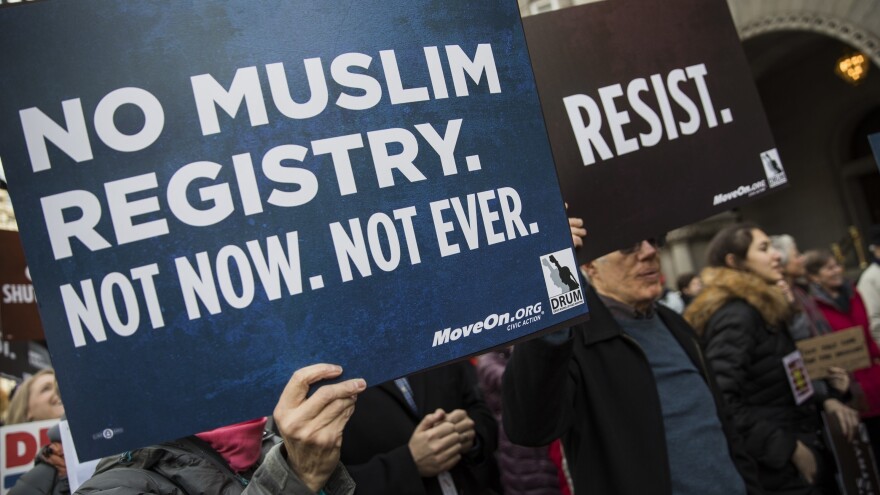President Trump's executive order limiting immigration from majority-Muslim countries, which ignited protests across the country last weekend, joins a list of controversial presidential decrees through the years that have been aimed at foreign or domestic racial and ethnic groups.
Trump's executive order, titled "Protecting the Nation From Foreign Terrorist Entry Into the United States," not only bans entry from seven countries — Syria, Iraq, Iran, Libya, Sudan, Somalia and Yemen — but also gives priority to religious minorities in those countries.
The order requires several federal agencies to conduct in-person interviews during the visa process and develop a way "to evaluate the applicant's likelihood of becoming a positively contributing member of society and the applicant's ability to make contributions to the national interest; and a mechanism to assess whether or not the applicant has the intent to commit criminal or terrorist acts after entering the United States."
Whether popular or divisive, Trump's hard-line move to restrict entry into the U.S. is only one more instance where such actions, based on race, ethnicity or nation of origin, have flowed from security concerns, fear or bigotry.
The Chinese Exclusion Act; The Geary Act
At the end of the 19th century, Chinese immigrants, blamed for depressing wages and cast as a threat to social order, became the first ethnic group to be specifically banned from immigrating to the U.S.
The Chinese Exclusion Act of 1882, signed into law by President Chester A. Arthur, did not initially require Chinese immigrants or residents to register with the U.S. government. Registration came 10 years later under President Benjamin Harrison when the Exclusion Act expired and Congress passed the Geary Act, which extended the provisions of the Exclusion Act and added registry as one of the conditions.
Under the Geary Act, "any Chinese person[s] or person[s] of Chinese descent" arrested under the act would be considered unlawfully in the country unless they could prove they were legal residents. Because being on the registry provided that proof, anyone of Chinese descent, legal resident or not, essentially had to register.
Anyone unable to register because of an injury or illness was required to provide proof of residency and have a "white witness" who could verify his claim.
Executive Order 9066: Japanese Internment
On Feb. 19, 1942, two months after the Japanese attack on Pearl Harbor, President Franklin D. Roosevelt signed Executive Order 9066. While it did not specifically target Japanese-Americans, the order was worded so that the military could round up and imprison anyone deemed a threat to national security. Roosevelt ordered that:
"All persons may be excluded, and with respect to which, the right of any person to enter, remain in, or leave shall be subject to whatever restrictions the Secretary of War or the appropriate Military Commander may impose in his discretion."
Order 9066 resulted in the internment of Japanese-Americans, who were required to self-report for relocation to 10 internment camps in California, Arizona, Wyoming, Colorado, Utah and Arkansas.
The order did not create a national registry similar to the Geary Act, but the U.S. eventually sent more than 100,000 Japanese-Americans to the camps.
Executive Order 12172: Iranian Hostage Crisis
In November 1979, seven months after the Islamic Revolution, the American Embassy in Tehran was overrun by a mob estimated at 3,000 people. They took 66 hostages, holding 52 for more than a year.
In response, President Jimmy Carter signed several executive orders targeting Iran and its U.S. interests. Executive Order 12172 focused on Iranian nationals in the U.S.
Carter's administration created a national registry for all Iranian students as fears rose that people aligned with Ayatollah Ruhollah Khomeini might enter the country.
Iranian students were required to report to the Immigration and Naturalization Service, where they would have to show a passport, arrival and departure forms for immigration, and proof of full-time enrollment in school, including a completion date and current address.
When reporting to the INS, students would also have their duration status in the country changed from "indefinite" to one-year increments. They were required to repeat the process every year until they completed their degree.
On Dec. 27, after his executive order was declared constitutional by an appeals court, Carter issued a statement claiming that "more than 45,000 of the nearly 55,000 students interviewed under the program were found to be in the country legally. Some 6,500 were found to be out of status, with the balance requiring a further check of documents."
The following April, Carter announced that all Iranian visas were immediately invalidated, with a few exceptions made for such things as humanitarian concerns.

NSEERS: A Muslim Registry?
Soon after the terrorist attacks on Sept. 11, 2001, President George W. Bush's administration implemented the National Security Entry-Exit Registration System, commonly referred to as NSEERS, to mitigate the fears of more attacks from Muslim extremists abroad.
All but one of the 25 countries targeted had Muslim-majority populations. The program required noncitizen males 16 and older to report to immigration officials for interviews at designated entry and exit ports.
And while the U.S. tracks all visitors entering and leaving the country, NSEERS went further in requiring annual reporting updates and asking questions that Brooklyn College professor Moustafa Bayoumi said infringe upon free thought and free expression. Bayoumi, author of How Does It Feel To Be a Problem?: Being Young and Arab in America,said NSEERS officials asked "questions that did not concern their immigration status."
The program that once cost as much as $10 million annually became less relevant as the use of biometric data increased, and it was halted in the spring of 2011.
The thing to note about the NSEERS program, Bayoumi said, was that it registered more than 180,000 men and boys, but "led to not one single terrorist charge. Not a single one."
Jorge Encinas is a freelance journalist based in Tucson, Ariz., and former intern with the Code Switch team. Follow him @jencinas9.
Copyright 2021 NPR. To see more, visit https://www.npr.org. 9(MDA5NTM4MTIyMDE0MTg3NDc2MTVlZjdmNQ001))






